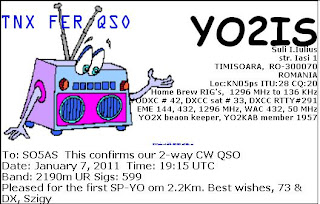While waiting for the boardhouse to make the printed circuit boards for my frequency synthesiser, ( see post on Mar 8, 2011 ), I reckoned I should have just enough time at long last to build the low noise 144MHz receiver RF preamplifier which I designed months ago, ( see post on June 16, 2010 for circuit schematic ). For this piece of equipment I again made the pcb; the artwork for it is shown, ( actual size 4.2" x 2.2" ).
I built the circuit on single-sided copper laminated fibre-glass board, all components being mounted on the same side as the tracks and copper ground-plane; in effect surface mount technology even though only the BF991 mosfet, in a SOT143 package, is actually a surface mount device. A piece of double-sided board material was soldered vertically across the circuit board to act as a screen to prevent coupling between the input and output tuned circuits. The preamplifier is housed in a Hammond "Eddystone line" type 27134PSLA die-cast metal enclosure, 111x60x31mm.
Being somewhat larger than a matchbox, it's not the tinyest rf preamplifier that I have ever seen. Small size is not an issue for me, as it will not be installed internally in any other equipment but used outdoors close to the antenna. Besides that, the heavy-duty change-over relays that will be necessary to divert the transmitted signal around the preamplifier will add significantly to the overall size anyway.
Achieving a low noise figure for the preamplifier is strongly dependent on the C-C-L input bandpass filter and matching circuit which should use low loss, ( i.e., high 'Q' ), components. I easily obtained some suitable ceramic trimmer capacitors for C1 and C2, but sadly no silver plated wire from which to make the coil L1 !































